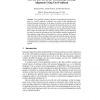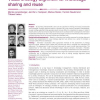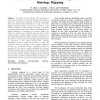ESWS
2009
Springer
13 years 11 months ago
2009
Springer
In different areas ontologies have been developed and many of these ontologies contain overlapping information. Often we would therefore want to be able to use multiple ontologies....
SEMWEB
2010
Springer
13 years 11 months ago
2010
Springer
The Web of Data currently coming into existence through the Linked Open Data (LOD) effort is a major milestone in realizing the Semantic Web vision. However, the development of app...
SEMWEB
2010
Springer
13 years 11 months ago
2010
Springer
Abstract. A key problem in ontology alignment is that different ontological features (e.g., lexical, structural or semantic) vary widely in their importance for different ontology ...
IJBRA
2010
14 years 4 days ago
2010
: In recent years, the number of ontologies shared on the Web has increased dramatically, supporting a growing set of applications such as biological knowledge sharing, enhanced se...
IJSWIS
2007
14 years 1 months ago
2007
Ontology alignment foundations are hard to find in the literature. The abstract nature of the topic and the diverse means of practice make it difficult to capture it in a universal...
JKM
2008
14 years 1 months ago
2008
Purpose
FOIS
2006
14 years 3 months ago
2006
An ontology alignment is the expression of relations between different ontologies. In order to view alignments independently from the language expressing ontologies and from the te...
SWWS
2008
14 years 3 months ago
2008
- The future of the Semantic Web envisions an interconnected network of data and systems where software agents can communicate seamlessly to perform complicated tasks with limited ...
MEDINFO
2007
14 years 3 months ago
2007
Objectives: To compare the alignments of two large anatomical ontologies (the Foundational Model of Anatomy and GALEN) produced by three ontology alignment systems (AOAS, FALCON a...
ESWS
2008
Springer
14 years 3 months ago
2008
Springer
Evaluation of ontology alignments is in practice done in two ways: (1) assessing individual correspondences and (2) comparing the alignment to a reference alignment. However, this ...







